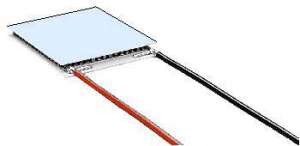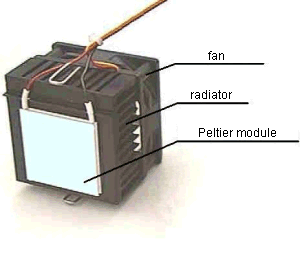 |
||
|
||
| ||
The work of modern efficient electronic devices dissipates a lot of heat, especially while overclocking. Effective work of such components require adequate cooling. As a rule, we use fan based coolers. The reliability and performance of them grow constantly due to construction improving, usage of the latest technologies for sensor development. However, not so long ago there appeared new-based cooling devices - semiconductor coolers which utilize the Peltier effect. Peltier coolers containing specific semiconductor thermoelectric modules have the widest perspective in the market for cooling devices. Thanks to their unique heat and operational characteristics, Peltier modules allow to reach the required cooling of computer components without huge technical problems and finance expenditure. They are quite compact, convenient, reliable and efficient. In the systems, elements of which are operated in the tough temperature modes (i.e. in case of overclocking), Peltier modules are of great interest. Peltier modulesPeltier coolers feature thermoelectric coolers based on the Peltier effect. The given effect was named after a French watchmaker Jean Charles Athanase Peltier (1785-1845.), who discovered it in 1834. If you put a drop of water in the hollow on the joint of 2 semiconductors Sb and Bi, and switch on the current, the drop would freeze (with the reverse direction of the current the drop would melt). This is how Peltier effect works. Unlike the Joule heat which is proportional to the current strength squared (Q = R*I*I*t), the Peltier is proportional to the current strength and changes the sign (-/+) if the current changes the direction. The Peltier heat equals: Qp = P*q where q = I*t, P is a Peltier factor that depends on contacting materials and temperature. Peltier heat is considered positive in case of dissipation, and negative in case of absorption.  Fig.1. The scheme of the experiment of Peltier heat measuring, Cu, Bi. In this case the Joule heat in both calorimeters is the same (since R = R(Cu)+R(Bi)). But the Peltier heat differs in the sign. So, this experiment allows to calculate the Peltier factor. In the table below you can see some Peltier factors for different pairs of metals.
Usually, a Peltier factor is calculated this way: P = a*T Where P is the Peltier factor, a is the Tomson factor, T is the absolute temperature. In theory, the Peltier effect is explained the following way: electrons speed up or slow down under the influence of contact potential difference. In the first case the kinetic energy of the electrons increases, and then, turns into heat. In the second case the kinetic energy decreases and the joint temperature falls down. In case of usage of semiconductors of p- and n- types the effect becomes more vivid. On the scheme you can see how it works. COLD  HEAT Fig.2. p- and n-type semiconductors in thermoelectric coolers Combination of many pairs of p- and n-semiconductors allows to create cooling units - Peltier modules of relatively high power (see the scheme below).  Fig.3. Structure of a Peltier module A Peltier module consists of semiconductors mounted successively, which form p-n- and n-p-junctions. Each junction has a thermal contact with heatsinks. When switching on the current of the definite polarity, there forms a temperature difference between the heatsinks: one of them warms up and works as a heatsink, the other works as a cooler.  Fig.4. A Peltier module A typical module provides a temperature difference of several tens degrees Celsius. With forced cooling of the hot heatsink, the second one can reach the temperatures below 0 Celsius. For more temperature difference the cascade connection is used.  Fig.5. An example of cascade connection of Peltier modules The cooling devices based on Peltier modules are often called active Peltier coolers or Peltier coolers. Peltier module's power depends on its size. The modules of low power might not be efficient enough. But the usage of the modules of too high power might cause moisture condensation, what is dangerous for electronic circuits. The distance between conductors on the modern printed circuit boards constitutes parts of a millimeter. Nevertheless, they were powerful Peltier modules and additional cooling systems which helped KryoTech and AMD companies to overclock AMD processors up to 1 GHz. We should notice here, that the systems work was stable and reliable enough. Similar experiments were made with Intel Celeron, Pentium II, Pentium III, which achieved tremendous performance growth. We should point out that Peltier modules dissipates a lot of heat. That's why it's necessary to use not only a powerful fan in the cooler, but also other different fans inside the case.  Fig.6. An outward appearance of a cooler with a Peltier module The information on Peltier modules, coolers and their test results you can find on the following sites: Write a comment below. No registration needed!
|
Platform · Video · Multimedia · Mobile · Other || About us & Privacy policy · Twitter · Facebook Copyright © Byrds Research & Publishing, Ltd., 1997–2011. All rights reserved. | |||||||||||||||||||||||||||||||||||||||||||||||||||||||||||||||||||||||||||||||||||||||||||